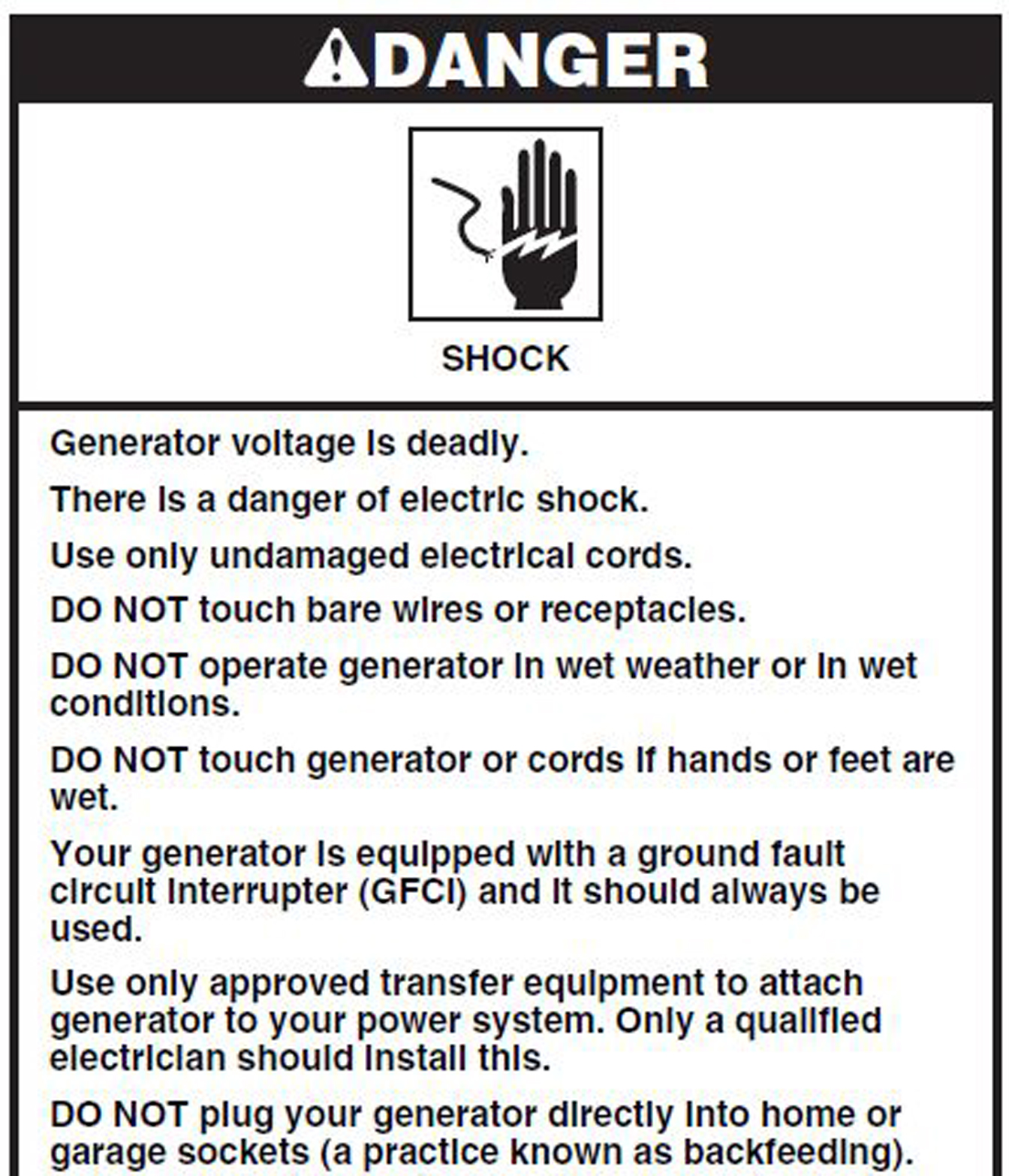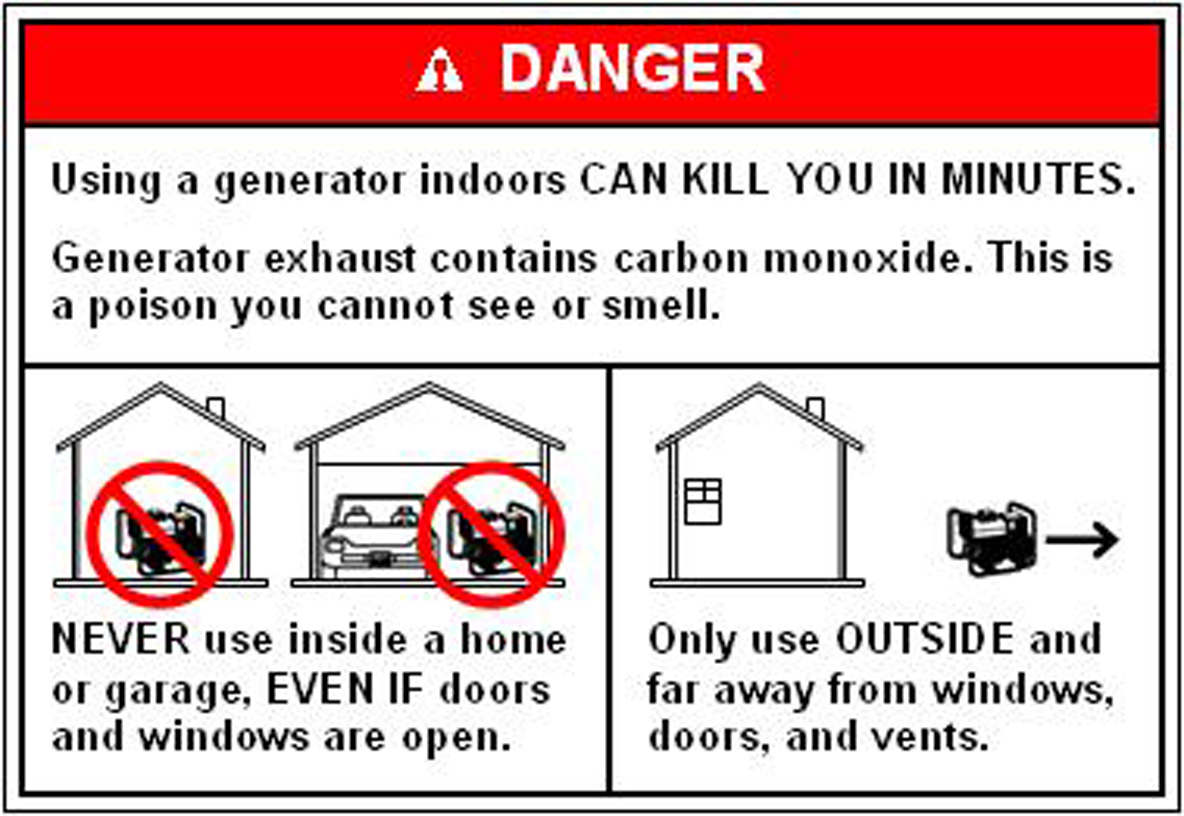Portable Generator Usage
Portable Generator Usage
Important safety considerations
 Every year, unfortunate carbon monoxide incidents occur as a result of improper outdoor use of generators. All generators display warning labels that explain the risk of death if operated inside a home or garage. Despite this, more than 400 deaths occur in the United States every year, according to the Consumer Products Safety Commission (CPSC).
Every year, unfortunate carbon monoxide incidents occur as a result of improper outdoor use of generators. All generators display warning labels that explain the risk of death if operated inside a home or garage. Despite this, more than 400 deaths occur in the United States every year, according to the Consumer Products Safety Commission (CPSC).
In order to fully understand the safety precautions they should take, owners must read the manual before operating. Never run a generator inside, including garages (even with the garage door open). Keep the generator at least 20 feet away from windows, doors, and vents. Failure to do so can result in poisoning from carbon monoxide.
However, carbon monoxide poisoning isn't the only danger posed by generators; electrocution is a concern as well. During power outages, many people turn to portable generators as a means to back up the lost utility. Generators should never be run in wet weather, as they can cause serious electrocution, or be damaged. Some people will try to create "dog houses" for their generators to keep them covered in the rain, but this is hazardous and can put the user at risk. Generators produce a lot of heat and, if enclosed on all four sides, will run too hot. Furthermore, if a generator is in a closed space alongside flammable materials, fire or serious injury can result.
If you need to run a generator while it is raining or snowing, it is important to keep it shielded from moisture. A safe way to do this is to use one of the new generator tent products. These products allow the generator to exhaust properly and stay cool, while also covering the outlets and control panel to reduce the chance of electrocution. They can be used in any wet weather, and are even tested to withstand gale force winds.
Refueling a generator seems simple, but there are still things that can go wrong. Make sure to use the right type of fuel. Fuel type will be listed on the generator or in the Owner's Manual. It is important to make sure the generator is off and has cooled down before refueling. If gasoline spills on the hot surface, flames could ignite. Also, don't store the fuel canister too close to a running generator; the heat produced by the generator could cause any spilled fuel to ignite.
To run appliances during an outage, plug them directly into the generator, or use a heavy-duty extension cord that is rated at least equal to the sum of the connected appliances. Also, never plug the generator into a wall outlet. This is known as "backfeeding", and can severely harm the line workers trying to restore power.
It isn't recommended to run a generator during hurricane force winds, since they could move the generator around. Also, never run a generator in wet weather, and don't run it in flood waters, either.
 According to the Portable Generator Manufacturers' Association's (PGMA), "Take it Outside" campaign, it's vital to know the symptoms of carbon monoxide poisoning. These include headache, nausea, shortness of breath, dizziness, and fatigue. The best way to stay alerted to the presence of carbon monoxide, is to have working detectors throughout the home. However, if a generator is running and someone begins to feel any of the above-mentioned symptoms, evacuate the structure immediately.
According to the Portable Generator Manufacturers' Association's (PGMA), "Take it Outside" campaign, it's vital to know the symptoms of carbon monoxide poisoning. These include headache, nausea, shortness of breath, dizziness, and fatigue. The best way to stay alerted to the presence of carbon monoxide, is to have working detectors throughout the home. However, if a generator is running and someone begins to feel any of the above-mentioned symptoms, evacuate the structure immediately.
When the power goes out, generators can be a lifesaver. However, generators also come with several consequences: carbon monoxide poisoning, electrocution, and fire. It is very important to not take these consequences lightly, and to make sure that all of the appropriate precautions are taken when running a generator.
There are plenty of great resources available to answer any questions. They can be found through the local utility companies, The American Red Cross, PGMA, the CPSC, and the local fire department. Even with these resources, it's important to always read the Owner's Manual first, and to ensure all carbon monoxide detectors are operational.
Mark Carpenter is the CEO, president and owner of GenTent Safety Canopies.
GenTent Safety Canopies | www.gentent.com
Volume: 2016 September/October







